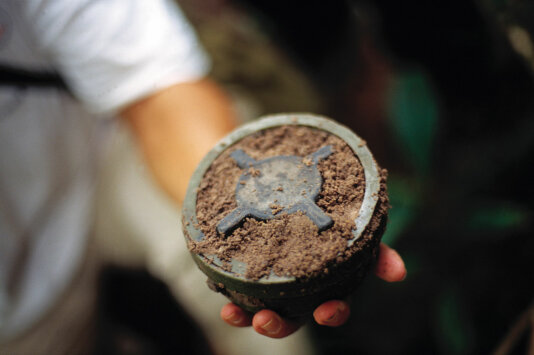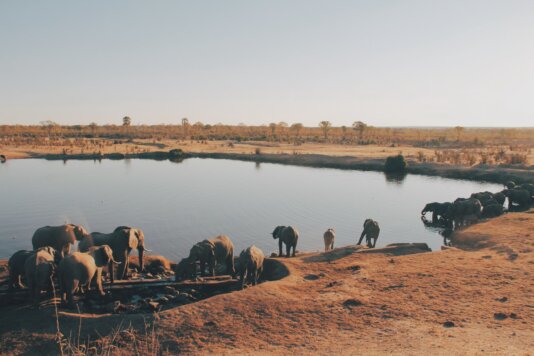- About
- Topics
- Picks
- Audio
- Story
- In-Depth
- Opinion
- News
- Donate
- Signup for our newsletterOur Editors' Best Picks.Send
Read, Debate: Engage.
| January 07, 2022 | |
|---|---|
| topic: | Conservation |
| tags: | #Africa, #Zimbabwe, #wildlife, #conservation, #landmines |
| located: | Zimbabwe |
| by: | Cyril Zenda |
In Zimbabwe, work as begun to clear anti-personnel landlines that, for decades, have posed serious a threat to prized wildlife as well as local communities who depend on the land for grazing and cultivation.
Since January 2021, the Belgian-registered global de-mining firm APOPO (Anti-Persoonsmijnen Ontmijnende Product Ontwikkeling or Anti-Personnel Landmines Removal Product Development) has been working along the Cordon Sanitaire (CORSAN) minefield that affects the Sengwe Wildlife Corridor in the south-eastern part of Zimbabwe. The firm estimates it will find and destroy about 15,300 anti-personnel landmines and clear around 7.23 million square meters.
“APOPO believes that it should be able to complete the task by 2025 or before with consistent donor support,” the organisation said.
“By clearing the landmines, APOPO can lay a strong foundation for communities to rebuild their lives and for agriculture and eco-tourism to return and thrive, bringing many benefits to the nation as a whole.”
Zimbabwe is one of the most heavily mined countries in the world, a legacy of the liberation war that ended over four decades ago.
The Sengwe Wildlife Corridor is a specifically designated area aimed at allowing free movement of wildlife between South Africa’s Kruger National Park and Zimbabwe’s Gonarezhou National Park. The landmines affect the wildlife in the three-nation Great Limpopo Transfrontier Park (GLTP), itself one of the world’s largest conservation areas, spanning South Africa, Mozambique and Zimbabwe.
“Animals cannot read ‘danger’ signposts and unknowingly surrounded by landmines; accidents inevitably occur,” pointed out APOPO. “For elephants, buffaloes and lions, this means the loss of a limb followed by a slow, painful death. Smaller animals die instantly.”
The minefield APOPO is clearing runs for 37 kilometers with an expected width of about 75 meters and thousands of deadly R2M2 anti-personnel landmines per km.
Zimbabwe, previously Rhodesia, gained its independence in 1980, bringing to an end a brutal bush war that cost more than 50,000 lives.
To deter the liberation fighters from easily entering the country from neighbouring Mozambique and Zambia, between 1976 and 1979, the Rhodesian army planted about three million anti-personnel mines in five major minefields stretching some 850 km along the country’s eastern and northern borders.
These dense belts of landmine contamination - some with about 5,500 mines per square km - have seriously retarded development. As of September 2018, the scale of landmine contamination in Zimbabwe is estimated to be over 66 million square meters.
Lisimati Makoti, who is Chief Sengwe in the Chikombedzi area, is happy that the landmine threat will finally be over.
“We are very happy that the landmines are being removed,” the chief told FairPlanet. He said that many people from his area had lost their lives and limbs to the hidden danger of land mines, in addition to losing countless livestock.
Since the end of the war in 1980, these anti-personnel mines have killed about 1,700 people and maimed over 2,000 others in Zimbabwe, while more than 120,000 cattle had also been killed.
Zimbabwe Parks And Wildlife Authority (ZimParks) spokesperson Tinashe Farawo confirmed to FairPlanet that landmines have affected wildlife, but could not provide statistics, saying cases of that nature were handled by the army.
While FairPlanet was unable to get any statistics from the Zimbabwe National Army, a demining expert revealed that such statistics are not readily available.
“It is very difficult to some up with figures on how many wild animals, and which types, have been killed by the landmines because everything happens in the forest and the carcasses of the dead animals are usually consumed by the carnivorous members of the wildlife family, and even those injured end up being finished off and eaten too,” the source said.
APOPO said that if not removed, this huge lethal barrier could have a long-term impact on the gene pool of species such as the African elephant.
“Gonarezhou National Park boasts a population of over 11,000 African elephants, one of the largest in Africa. Kruger National Park also has a similar sized population. Given the general continental decline of the African elephant, it is paramount for the long-term wellbeing of the species that these two healthy populations have safe access to each other to mix gene pools.”
The de-miner also pointed out that as a structural barrier, the landmines scare away safari and conservation-focused ecotourism operators.
“Kruger National Park receives a massive influx of tourists (over 1,800,000 a year), which could potentially travel up the Sengwe Corridor and into Gonarezhou National Park without requiring a visa or leaving the conservation area.
"Currently, Gonarezhou National Park receives virtually no international tourists. If even a small fraction of the Kruger National Park tourists made it to Gonarezhou National Park, the positive economic implications for Zimbabwe would be significant.”
The de-mining efforts in Zimbabwe have continuously been hampered by a serious lack of funds. The project only picked pace recently after some development partners started making available financial assistance to ensure that Zimbabwe meets its undertaking to the Anti-Personnel Mine Ban Convention (APMBC) to be a landmine-free country by 2025.
In addition to APOPO, there are four other demining missions operating in Zimbabwe. These include the Zimbabwe National Army’s National Mine Clearance Unit (NMCU), HALO Trust, Mines Advisory Group (MAG) and the Norwegian People’s Aid (NPA).
Image by UN
By copying the embed code below, you agree to adhere to our republishing guidelines.


